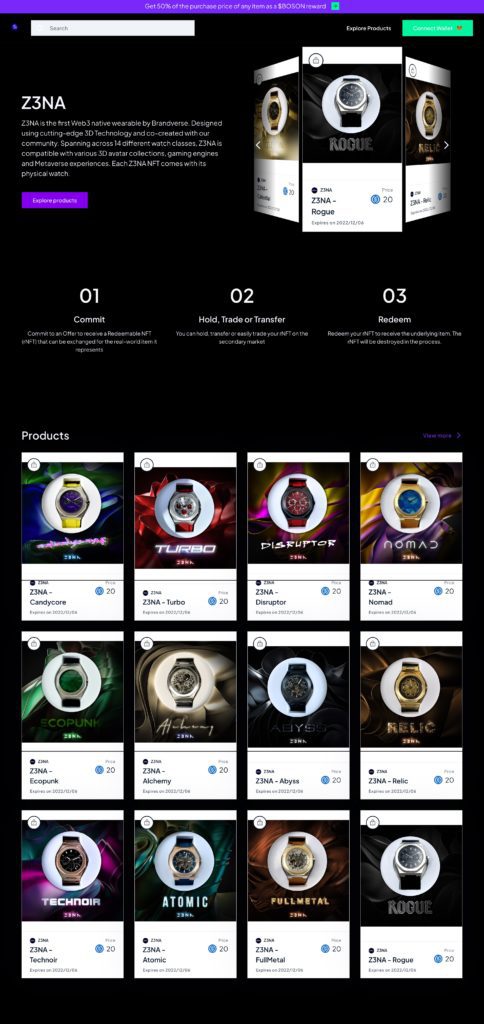Justin Banon’s vision is for Boson Protocol to be where all of the world’s products and services are listed and searchable, with code-automated commerce and no intermediary hogging fees.
Boson is building Web3’s commerce layer
Boson Protocol uses NFTs to create a decentralized version of e-commerce where private companies cannot monopolize the environment and profit off user data. Through the recently-released Boson dApp, merchants build commerce applications on top of its protocol that allow buyers and sellers to transact directly. They can customize their storefronts and deploy tokengating, enabling them to offer access to exclusive content, products, and services to customers holding specific NFTs. Some liken it to lifting Web3’s velvet rope.
Boson dApp changes e-commerce capability
Boson dApp is a neutral marketplace where folks can access all vendors on Boson. A widget captures all information needed to close a transaction. When they buy an item, customers receive a redeemable NFT.
That’s where things get interesting. Banon said. They can hold the item, gift it, redeem it, or trade it on a marketplace like OpenSea. Sellers set the redemption time frame, and independent third parties address dispute resolution. Through integration with SMTP decentralized messaging, customers can communicate with each other.
“One of the cool things that this does is the protocol performs the same sort of function that an Amazon or an eBay does,” Banon said. “But instead of having a company in the middle taking a slice, it does that just with code.”
The protocol is governed by a decentralized autonomous organization (DAO), so no one interest controls its path, Banon added.
See also:
Building customized, NFT-based commerce experiences
Boson offers solutions that are impossible with older e-commerce platforms, Banon said. He described traditional e-commerce as a linear exchange between buyer and seller. In Web3, companies can build specific experiences with customizable, NFT-based loyalty programs. They can gamify the process to engage their clientele. Boson is collaborating with Prof. Jason Potts, the co-director of RMIT Australia’s Blockchain Innovation Hub, to envision how a tokenized global economy would function.
“We can enable the seller to interact directly within the metaverse, and therefore Boson is the bridge between these new emerging worlds like the metaverse and the physical world,” Banon said.
Addressing smart contract limitations and data reliability

Banon said that Boson’s structure also solves the oracle problem, which has limited smart contract functionality. That functionality is determined by the quality of the data it receives. Boson’s design allows it to ensure its access to truly accurate transaction data.
“You can think of the data oracle problem as… a smart contract is a blockchain’s eyes and making sure they can see, and then a protocol like Boson is a smart contract’s hands, enabling it to act on the real world.
“So Boson enables a smart contract commitment to trade to be executed in the real world. That’s one of the fundamental things that we do. So this bundle of technologies it’s been a breakthrough. We’ve been awarded World Economic Forum technology pioneer status for solving this kind of breakthrough problem and for our potential to transform commerce.”
He added that they must also have that trust to function effectively in the real world.
Strong corporate demand for Web3 commerce
Corporate interest in Boson Protocol is high, Banon said. Some aren’t thinking Web3 as much as they want to target more mainstream audiences. Others are entirely in on developing Web3 commercial capability.
That counters the narrative that suggests some have bet too early on the metaverse. While there was a temporary drop in demand, the boom from 2021 carried over, Banon said. Boson is working with several multi-billion-dollar companies that are in this for the long term.
“There was a spike,” Banon admitted. “And now it’s going to be a slow burn, and I think it will grow over time.
“Where we’re seeing… maybe 50 times the demand is for Web3 commerce to sell physical things as NFTs off of websites, tokenizing physical assets to create these new asset classes, all of these different types of products and services. Whether that’s offered via the metaverse, web, or many APIs plugging into other systems, tokenizing assets so they can be held, transferred, or gifted is massive. That’s what we did to information 30 years ago.”
Those driving future growth
Youngers generations have embraced this, Banon said. People own the networks; they own part of the brands. They’re invested emotionally and financially.
“Once that catches fire… it’s what people want, what consumers want, and what everyone wants. That’s the big change we’ve been waiting for. This is no longer a technology-driven thing. This a consumer-driven movement.”